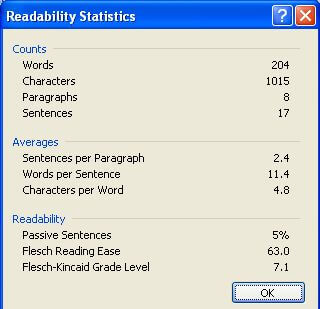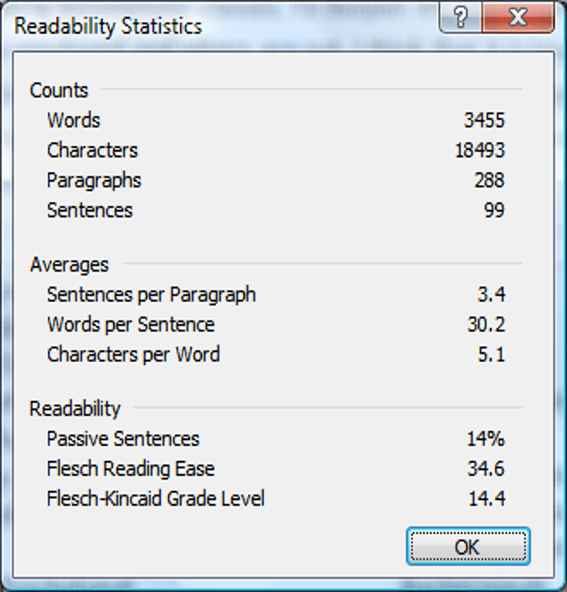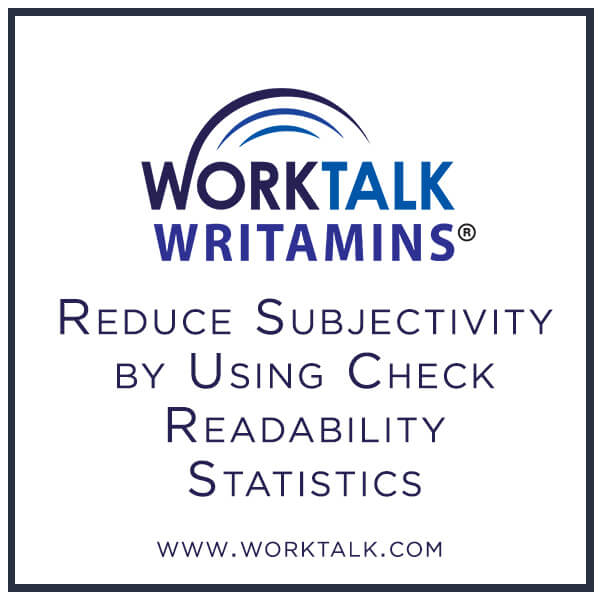[4 minutes to read]
Feedback on writing can seem very personal. It’s easy for the reviewer to say, “It doesn’t look right to me,” and thus easy for the writer to say, “She was just changing it to her personal style.” Many organizations grapple with the alienation, resentment, and poor results that come from editing that seems arbitrary or personal.
Fortunately, a tool exists that can take some of the subjectivity out of the review process. You can use it when editing your own work and the work of others. In a little-known feature called Check Readability Statistics, MS Word offers you a wealth of practical information about your document. Here’s what its report looks like:

How Do You Find Check Readability Statistics?
Microsoft does not make it easy to find this valuable function. Check under FILE, then OPTIONS. Choose PROOFING. Then choose “Show readability statistics.” If you have a problem, click HELP or check here. Different versions of Word may have different pathways to the function. If I were Microsoft, I would tell the world about this great function, but they didn’t ask my opinion.
How to Interpret the Report
The first section, Counts, gives you information that you may not care about unless you’re on a word diet. The second and third sections are juicier.
The Averages sectionshows you the average words per sentence. Keep this number around 20 and you’re golden. The characters-per-word average helps you see how many big words you have used. Too many long words will decrease the readability of your document
Understanding the Readability Section
The third section, Readability, offers you a wealth of crucial information. First, it tells you what percent of your sentences are in the passive voice. Remember, the passive voice is not evil; it’s just not direct. So if you aim to obfuscate, lay on the passive. If you aim to connect, keep the percent of passive sentences low – under 10%.
The most comprehensive number on the report is the Flesch-Kincaid Grade Level. Bear in mind that most popular newspapers and magazines are written at about a 6th-grade level. Thus, if your document is at a 7th or 8th-grade level, it’s just a little bit harder to read than People magazine.
Start ascending to the 11th, 12th, or college level, and your reader is going to have to rub a few neurons together to grasp your message. And let’s face it, those neurons are already occupied with the 57 other things on the reader’s mind. Your goal is to get the grade level as low as possible without sounding like an elementary school primer or sacrificing your meaning. Take a look at this person’s snapshot:

In a glance, you can see that she needs to revise. Her sentences average 30 words, which means she’s got some 40+-word doozies. Her passive sentences are over 10%, and she’s at a college reading level. Simply showing her this snapshot should suffice to let her know that the document is hard to read.
How to Use This Function
Click FILE. Look down the left side of the screen to find OPTIONS. Click PROOFING. Check all the grammar and readability options. Then, when you actually want to run this function, you need to go to REVIEW. CHECK DOCUMENT. It will take you through the rigmarole of correcting everything Microsoft thinks is wrong with your text. Then, when you have Bill Gates’s seal of approval, it will reward you with the readability snapshot.
If you have no patience for Word’s opinion and just want to get to the snapshot, scroll through the Review process and check “Do not check for this” at every opportunity. You will fly to the end of the process and get the snapshot.
Check Readability Statistics Reduces Subjectivity
The beauty of Check Readability Statistics is that it makes revision less personal. Your staff member may write a report that seems wordy to you. If you say, “This is too wordy,” or “Please rework this,” he may fume at the feedback. But if you say, “This document has an average sentence length of 30.2. Can you get it closer to 22?” you are asking him to respond to facts, not opinions.
Now that you know the secret of Check Readability Statistics, I hope you will use it whenever you review someone’s writing. Please tell everyone you know about this gold-mine of information!
If we could all live in a world where feedback was based on facts rather than opinions, we might even have world peace.

©2019 Elizabeth Danziger All rights reserved
BOOK YOUR STRATEGY CALL NOW Communication woes drag down productivity and morale. Book your free 30-minute “communications audit” consultation with Elizabeth Danziger. She will listen to your situation and suggest ways to improve communication in your organization right away. Contact her at lizd@worktalk.com or 310.396.8303. You can also book through www.calendly.com/worktalk.
~~~~~~~~~~~~~~~~~~~~~~~~~~~~~~~~~~~~~~~~~~~~~~~~~~~~~~~~~~~~~
Gain clarity today. Contact Elizabeth Danziger at lizd@worktalk.com or Emma Fialkoff at upworktalk@gmail.com to learn how you can generate better business through better writing.
